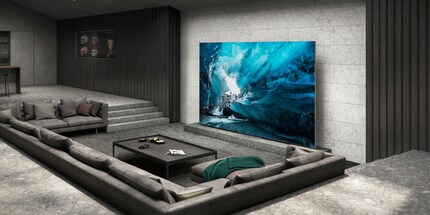
Background information
MicroLED vs. OLED: Which one’s going to prevail?
by Luca Fontana

Samsung has been preaching for years that its innovative TV technology was about to be ready for the market. Now the preaching has become reality: Micro LED televisions are finally available in Switzerland - for "only" 149 000 francs each.
"If Samsung has its way, then Micro LED is the second coming of TV Jesus," I wrote two years ago in an article about the TV innovations of 2021. No wonder: Micro LED is supposed to be a TV with a bright picture like LCD TVs, perfect black levels and rich colours like OLED TVs and - above all - no burn-in.
Since 2018, the South Koreans have been talking about it as if the launch of the egg-laying wool-milk sow for the living room was imminent. However, it was only recently launched on the domestic market. And only now in our country: Samsung is launching the first micro LED TVs in Switzerland in a media release.
Their price? 149,000 francs per television. For a 110-inch screen diagonal. Easy
Micro LED is a perennial topic at Samsung. The technology of the future. Since time immemorial. At least Samsung is the first manufacturer I heard about Micro LED for the first time. LG and Sony are now also busy researching the technology. Showing prototypes here and there. Or industrial models. Just not quite as loudly as Samsung. After all, OLED should not seem prematurely outdated.
But let's explain the technology as briefly as possible: Micro LED is basically the same as OLED - just without the carbon-containing material, "organic" in English, which gives OLED its name. Instead, micro LEDs rely on gallium nitride, a synthetic material. Micro LEDs therefore not only shine brighter than OLEDs, but also much longer without burning out. Hence the theory that micro LEDs do not cause burn-in. And because micro LEDs can be made much smaller than conventional LCD LEDs, the technology does not have blooming - rings of light around bright objects against a dark background.
The reason why Micro-LED was nevertheless long considered a dream of the future is its modular architecture: the screen does not consist of one panel, but of several. This means that Micro-LED displays can be built to almost any size - in Zurich, for example, you can find a 455-inch Micro-LED display in Hall 5 of the Arena Cinema.
However, the modules are problematic when building small screen diagonals that are relevant for home cinema, such as 65- or 55-inch screens. This is because the smaller the modules become, the smaller the light-emitting diodes themselves have to be. Nevertheless, Samsung has now released a 110-inch version for the Swiss market - even if only very few people can afford this huge TV. And: According to the media release, the 101-inch, 89-inch and 76-inch sizes will be available to order. However, no prices are mentioned.
Samsung is still keeping quiet about the resolution. However, the company is advertising 25 million micrometre-sized RGB LEDs. That is enough to infer the resolution. TV pixels usually consist of three sub-pixels - in this case the RGB LEDs. This results in 8.3 million pixels. This in turn corresponds to the UHD resolution of 3840×2160 pixels. To be honest: I think that UHD resolution is a bit low for 110-inch diagonals.

The interesting thing is that Samsung is not talking about sub-pixels, which are later coloured by colour filters, but RGB pixels. RGB stands for red, green and blue. The media release also explicitly states that the TV does not require colour filters. That sounds like an advantage to me. Colour filters can have a negative effect on the light intensity of the colours. This is why QD OLED televisions are already regarded as the superior further development of conventional OLED televisions. Above all, this should have a positive effect on colour fidelity and colour space coverage.
We also know that the TV will have a micro AI processor. This should not only help to tease the last ounce of quality out of every single film or series frame, but also reproduce Dolby Atmos via the top, side and bottom speakers integrated into the TV. This is done by "processing sound objects by the processor" so that "voices come out clearly" and "ambient sounds are immersive". Whatever that means.
According to the media release, the TV is currently available both in stores and from selected specialist retailers. But unfortunately not (yet) in our online shop. My colleague Robin Sutter from Purchasing is already clarifying the situation. If there is any news, I will update you in this article.
If you want to see the micro LED TV live and in a showroom right now - despite the fantastic price - you can do so at the following specialist retailers:
All in all, the future that Samsung has been talking about for what feels like ages is finally here. At least for the top one per cent. It will probably be a few years before micro LED TVs become "slightly" smaller and, above all, more affordable. And hey - someone has to bear the horrendous research and development costs of the technology.
Cover photo: Samsung Newsroom SwitzerlandI'm an outdoorsy guy and enjoy sports that push me to the limit – now that’s what I call comfort zone! But I'm also about curling up in an armchair with books about ugly intrigue and sinister kingkillers. Being an avid cinema-goer, I’ve been known to rave about film scores for hours on end. I’ve always wanted to say: «I am Groot.»